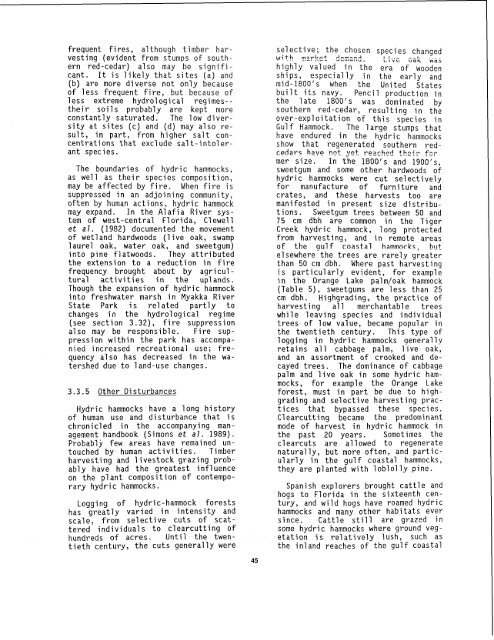The Ecology of Hydric Hammocks - USGS National Wetlands ...
The Ecology of Hydric Hammocks - USGS National Wetlands ...
The Ecology of Hydric Hammocks - USGS National Wetlands ...
Create successful ePaper yourself
Turn your PDF publications into a flip-book with our unique Google optimized e-Paper software.
frequent fires, a1 though timber harvesting(evident from stumps <strong>of</strong> southernred-cedar) also may be signifi -cant. It is likely that sites (a) and(b) are more diverse not only because<strong>of</strong> less frequent fire, but because <strong>of</strong>less extreme hydrological regimes--their soils probably are kept moreconstantly saturated. <strong>The</strong> low diversityat sites (c) and (d) may also result,in part, from higher salt concentrationsthat exclude sal t-intolerantspecies.<strong>The</strong> boundaries <strong>of</strong> hydri c hammocks,as well as their species composition,may be affected by fire. When fire issuppressed in an adjoining communi ty,<strong>of</strong>ten by human actions, hydric hammockmay expand. In the Alafia River system<strong>of</strong> west-central Florida, Clewel 1et al. (1982) documented the movement<strong>of</strong> wetland hardwoods (live oak, swamplaurel oak, water oak, and sweetgum)into pine flatwoods. <strong>The</strong>y attributedthe extension to a reduction in firefrequency brought about by agri culturalactivities in the uplands.Though the expansion <strong>of</strong> hydric hammockinto freshwater marsh in Myakka RiverState Park is related partly tochanges in the hydro1 ogi cal regime(see section 3.32), fire suppressionalso may be responsible. Fire suppressionwithin the park has accompaniedincreased recreational use; frequencyalso has decreased in the watersheddue to land-use changes.3.3.5 Other Disturbances<strong>Hydric</strong> hammocks have a long history<strong>of</strong> human use and disturbance that ischronicled in the accompanying managementhandbook (Simons et a7. 1989).Probably few areas have remained untouchedby human activities. Timberharvesting and 1 ivestock grazing probablyhave had the greatest influenceon the plant composition <strong>of</strong> contemporaryhydric hammocks.Logging <strong>of</strong> hydric-hammock forestshas greatly varied in intensity andscale, from selective cuts <strong>of</strong> scatteredindividual s to clearcutting <strong>of</strong>hundreds <strong>of</strong> acres. Until the twentiethcentury, the cuts generally wereselective; the chosen species changedwith m2rket dz~:c?. I, :.,-highly valued in the era <strong>of</strong> woodenships, especially in the early andmid-1800's when the United Statesbuilt its navy. Pencil production inthe late 1800's was dominated bysouthern red-cedar, resul ti nq in theover-exploitation <strong>of</strong> this species inGulf Hammock. <strong>The</strong> large stumps thathave endured in the hydric hammocksshow that regenerated southern redcedarshave no+ yet reached their f:rmer size. In the 1800's and 1900's,sweetgum and some other hardwoods <strong>of</strong>hydric hammocks were cut selectivelyfor manufacture <strong>of</strong> furniture andcrates, and these harvests too aremanifested in present size distri butions.Sweetgum trees between 50 and75 cm dbh are common in the TigerCreek hydri c hammock, 1 ong protectedfrom harvesting, and in remote areas<strong>of</strong> the gulf coastal hammocks, butelsewhere the trees are rarely greaterthan 50 cm dbh. Where past harvestingis particularly evident, for examplein the Orange Lake palm/oak hammock(Tab1 e 5), sweetgirms are less than 25cm dbh. Highgrading, the practice <strong>of</strong>harvesting all merchantable treeswhile leaving species and individualtrees <strong>of</strong> low value, became popular inthe twentieth century. This type <strong>of</strong>1 oggi ng in hydri c hammocks general 1 yretains all cabbage palm, live oak,and an assortment <strong>of</strong> crooked and decayedtrees. <strong>The</strong> dominance <strong>of</strong> cabbagepalm and live oak in some hydric hammocks,for example the Orange Lakeforest, must in part be due to highgradingand selective harvesting practicesthat bypassed these species.Clearcutting became the predominantmode <strong>of</strong> harvest in hydric hammock inthe past 20 years. Sometimes thecl earcuts are a1 1 owed to regeneratenaturally, but more <strong>of</strong>ten, and particularly in the gulf coastal hammocks,they are planted with loblolly pine.uc; ;ak ~;l;Spanish explorers brought cattle andhogs to Florida in the sixteenth century,and wild hogs have roamed hydrichammocks and many other habitats eversince. Cattle still are grazed insome hydric hammocks where ground vegetationis relatively lush, such asthe inland reaches <strong>of</strong> the gulf coastal

















